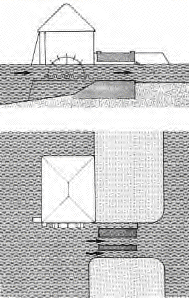|
|
A Gazetteer of Tidemills
in England & Wales ; past and present
Obtaining
energy from tidal movement is becoming increasingly popular (in theory) due to
its 'green' credentials. The only commercially viable modern one is on the
Barrage de la Rance in northern Brittany which has an exceptionally large
intertidal range. In practice the capital and maintenance costs are so high as
to make it uneconomic and these were among the reasons for the extinction of
tidemills.(known as tidal mills in the New World)
Many tidemills
are situated on creeks so that some of them were, in reality, semi-tidal i.e.
they do not have a millpond. Definition of what a tide mill is, as opposed to a
watermill, is futile. Apart from the failure to maintain them properly, the
main problem for tide mills was damage from tidal surge so that most were
situate in tidal estuaries. The final factor in their demise was WWI which removed
cheap labour from the market in addition to the reluctance to work the unsocial
hours as dictated by the times of the tides.
At first sight
there seems a strong correlation between tidemills and saltworkings but there
is no direct link although some old saltern feed ponds seem to have become
millponds. Both benefit from the same geophysical conditions.
Few tidemills
have been found (worldwide) outside southern England and even there the
distribution is mainly localised to Hampshire (and adjacent West Sussex) and
the Fal and Tamar estuaries in Devon and Cornwall. These are areas of small
streams where good sites for watermills are uncommon. As Carew described the
Cornish tidemills 'Amongst other commodities afforded by the sea, the
inhabitants make use of divers creeks for grist-mills, by thwarting a bank from
side to side, in which a flood-gate is placed with two leaves: these the
flowing tide openeth, and after full sea the weight of the ebb closeth fast,
which no other force can do, and so the imprisoned water payeth the ransom of
driving an under-shot wheel for his enlargement'.
Mode of
operation


◄ With an incoming tide the
sluice is opened to allow the pond to fill.
The sluice is
then closed and, after the tide has ebbed, it is operated like an ordinary
watermill ►
(illustrations
courtesy Birlot mill site)
Only sites
with a NGR have been checked. This is an ongoing procedure.
SITES
|
|
|
|
|
Acknowledgements
to the various members of the lists who responded to my enquiry and to the NMR.
Any list of
this nature is never complete. Criticisms, corrections and additions to
![]()
Much of the information comes ultimately from the Simmons
collection in the Science Museum
Abbreviations
M- Minchinton
W- Wailes
P- Pamplin
grant Hants RO 5M50/1955
T- W
Minchinton 'Tide mills of England and Wales' in K Major (ed) Transactions of
the 4th Symposium [of] the International Molinological Society, Matlock,
England, 1-8 September 1977 . Society for the Protection of Ancient Buildings
Wind and Watermill Section. Wind and Watermill Section, for the International
Molinological Society - 1978
M Ellis. Water
& windmills in Hampshire & IOW. SUIAG . 1978
FE Halliday
(ed.) Richard Carew of Antony; the Survey of Cornwall &c. 1953
R Wailes.
Tidemills of England & Wales. Trans. Newcomen Soc. 19 1938-9.1-35
(reprinted later in Edgar Allen News and by SPAB)
Minchinton Walter
Edward and Perkins John 1971. Tidemills of Devon and Cornwall. Exeter
Industrial Archaeology Group, Series Exeter Papers in Industrial Archaeology 2
Smith Diana.
1989. The tide mill at Eling Publisher: Ensign
Pelham R. 'The old mills of
Southampton'. Southampton Papers Number Three, 1963.
Acknowledgements
to the National Monuments Records, West Sussex SMR and the various contributors
